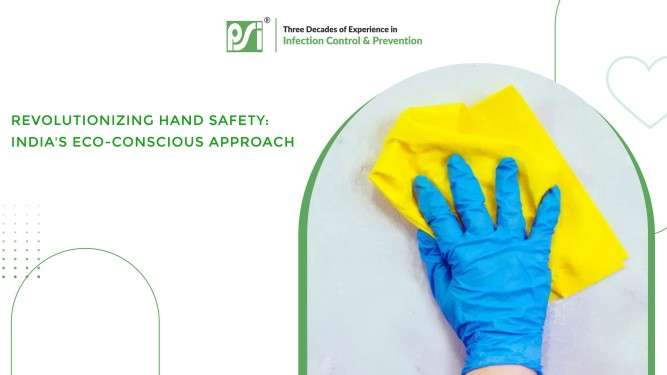One of the best Surgical Disposables company. I am dealing with them for the past 5 years,
their products are world-class. Their approach to trade is professional. All the best wishes to
them.
Revolutionizing Hand Safety: India's Eco-Conscious Approach
- By: Plasti Surge Industries

Hand safety is a crucial aspect in various industries, including manufacturing, construction, and chemical processing. The hands are vital tools in many jobs, but they are also extremely vulnerable to injury. Traditional hand safety measures often involve the use of protective gloves, which are designed to shield hands from cuts, burns, chemical exposure, and other workplace hazards. However, these traditional measures face several challenges and risks.
Firstly, the durability and effectiveness of gloves can vary significantly, affecting their protective capabilities. Inadequate glove quality can lead to accidents and injuries. Secondly, the environmental impact of producing and disposing of gloves, especially those made from non-biodegradable materials, is a growing concern. This leads to the significance of 'Environmentally safe gloves in India'. As India is a hub for various industries, the shift towards environmentally friendly gloves is vital. These gloves not only protect workers but also align with global sustainability goals, reducing the carbon footprint and waste associated with traditional gloves. However, developing gloves that are both safe for workers and the environment remains a challenging endeavor, necessitating innovation and commitment from both manufacturers and industry leaders.
Current Scenario in India
- Limited Availability of Eco-Friendly Options: Despite the growing awareness of environmental issues, eco-friendly hand protection options in India are still limited. This scarcity makes it challenging for industries to switch to greener alternatives.
- Lack of Standardization and Regulation: India faces a challenge in standardizing and regulating hand safety practices. There's a wide disparity in the quality and safety standards of gloves, especially in eco-friendly variants.
- Economic Constraints: Many industries in India operate on tight budgets, making it difficult to invest in more expensive eco-friendly hand protection solutions. This often leads to the preference for cheaper, traditional gloves, which may not be environmentally friendly.
- Awareness and Education: There is a lack of awareness about the importance of eco-friendly hand protection in India. Workers and employers often prioritize immediate protection over environmental considerations.
- Disposal and Recycling Challenges: Even when eco-friendly gloves are used, proper disposal and recycling practices are not always followed, undermining their environmental benefits.
- Innovation and Research: India is still in the early stages of developing and adopting innovative eco-friendly hand protection solutions. More research and investment are needed to create effective and sustainable options.
- Industry-Specific Needs: Different industries have unique hand protection requirements. The current market may not offer adequate eco-friendly options that meet the specific needs of all sectors.
- Supply Chain Issues: Eco-friendly hand protection products in India often face supply chain challenges, including inconsistent supply and increased costs, affecting their availability and affordability.
- Compliance and Enforcement: There is a need for stronger enforcement of safety regulations and guidelines to ensure that industries adopt eco-friendly hand protection practices.
- Collaboration and Partnerships: There's a growing need for collaboration between the government, industry leaders, and manufacturers to develop and promote eco-friendly hand protection in India, addressing both safety and environmental concerns.
Environmental Impact of Traditional Hand Safety Products
 The environmental consequences of commonly used hand safety materials, particularly disposable gloves and other protective gear, are significant and multifaceted. These impacts are prompting a shift towards sustainable glove options in India and globally.
The environmental consequences of commonly used hand safety materials, particularly disposable gloves and other protective gear, are significant and multifaceted. These impacts are prompting a shift towards sustainable glove options in India and globally.
- Waste Generation: Traditional disposable gloves, often made from materials like latex, nitrile, and vinyl, contribute to significant waste. After use, these gloves are typically discarded, adding to the already mounting problem of non-biodegradable waste in landfills.
- Resource Consumption: The production of disposable gloves requires considerable amounts of raw materials and energy. This includes the use of petrochemicals for synthetic gloves, which also contribute to the depletion of non-renewable resources.
- Carbon Footprint: The manufacturing, transportation, and disposal of disposable gloves contribute to greenhouse gas emissions. The entire lifecycle of these products, from production to disposal, adds to the carbon footprint of industries using them.
- Chemical Pollution: The production process of many disposable gloves involves chemicals that can be harmful to the environment. This includes the use of solvents and other toxic substances, which can lead to soil and water pollution.
- Biodiversity Impact: The disposal of non-biodegradable gloves can affect terrestrial and marine ecosystems. Wildlife can mistake glove waste for food, leading to ingestion and entanglement hazards.
In response to these environmental concerns, there is a growing interest in sustainable glove options in India. These include:
- Biodegradable Materials: Gloves made from biodegradable materials, such as natural rubber or bioplastics, are being developed. These materials decompose more quickly and reduce long-term environmental impact.
- Recycling Programs: Some companies are initiating recycling programs for disposable gloves, where used gloves are collected and repurposed, reducing waste.
- Reusable Gloves: There is a push towards using more durable, reusable gloves in industries where it is feasible. These gloves can be cleaned and reused, significantly reducing waste.
- Eco-Friendly Manufacturing Processes: Efforts are being made to produce gloves using more environmentally friendly processes, reducing chemical use and lowering carbon emissions.
- Local Production: Local manufacturing of gloves can reduce transportation emissions and support local economies, contributing to a more sustainable glove supply chain in India.
The shift towards sustainable glove options in India represents an important step in reducing the ecological footprint of hand safety materials, aligning industrial safety needs with environmental sustainability.
Eco-Friendly Alternatives
Innovative eco-friendly materials and technologies for hand safety are revolutionizing the industry, with 'Biodegradable gloves in India' being at the forefront of this green transition. These advancements focus on reducing environmental impact while maintaining, or even enhancing, the protective qualities of hand safety gear.
- Biodegradable Gloves: A significant innovation in this field is biodegradable gloves. In India, these gloves are made from materials like natural rubber or bioplastics that decompose more quickly than traditional synthetic materials. They are designed to retain their protective qualities during use but break down efficiently in a landfill environment.
- Sustainable Fabrics: Gloves made from sustainable fabrics, such as organic cotton, hemp, or recycled polyester, are gaining popularity. These materials are renewable and have a lower environmental footprint compared to conventional materials. They are particularly useful in industries where less intensive hand protection is required.
- Plant-Based Materials: Gloves made from plant-based materials like PLA (Polylactic Acid), derived from cornstarch or sugarcane, offer an eco-friendly alternative to traditional plastics. These materials are not only biodegradable but also often require less energy to produce.
- Recycled Materials: Using recycled materials to manufacture gloves helps reduce waste. Gloves made from recycled plastics or textiles can provide effective protection while also contributing to a circular economy.
- Eco-Friendly Coatings: Innovations in glove coatings, such as water-based polyurethane, provide necessary grip and durability without the environmental harm associated with traditional coatings. These coatings are less toxic and more sustainable.
- Reduced Chemical Processing: Eco-friendly gloves often involve reduced chemical processing in their production, minimizing harmful emissions and reducing water pollution.
- Compostable Options: Some biodegradable gloves are also compostable, breaking down in composting facilities and returning nutrients to the soil, thereby closing the loop in the product life cycle.
- Reusable and Washable Gloves: Reusable gloves that can be easily washed and disinfected for multiple uses significantly reduce waste and environmental impact. This approach is particularly relevant in non-hazardous environments.
These green alternatives in hand safety, particularly biodegradable gloves in India, demonstrate a commitment to environmental sustainability without compromising on the safety and protection of workers. As technology advances, these eco-friendly solutions are expected to become more widespread and effective.
Innovative Technologies
The intersection of technological advancements and environmental sustainability is leading to innovative solutions in hand protection, with 'Environmentally safe gloves in India' being a notable example. These advancements not only enhance safety measures but also prioritize ecological considerations.
- Smart Gloves: Smart gloves equipped with sensors and IoT (Internet of Things) technology are a major advancement. These gloves can monitor environmental conditions, detect hazardous chemicals, or track repetitive motions to prevent injuries. By providing real-time data, they enhance safety measures significantly.
- Wearable Tech Integration: Wearable technology, when integrated with gloves, can alert users to potential dangers, track their health metrics, or even guide them through complex tasks using haptic feedback. This technology ensures a higher level of safety while performing delicate or dangerous tasks.
- Biodegradable Smart Materials: Innovations in biodegradable materials are being combined with smart technologies. Gloves made from eco-friendly materials now incorporate conductive fibers or biodegradable electronics, offering the dual benefits of safety and sustainability.
- Eco-Friendly Production Methods: Technological advancements in manufacturing processes are reducing the environmental impact of producing gloves. This includes reduced water usage, lower emissions, and minimal chemical waste, aligning with the concept of environmentally safe gloves in India.
- Recycling and Upcycling Tech: New technologies facilitate the recycling and upcycling of gloves. Advanced sorting and processing systems help in efficiently recycling used gloves, turning them into new products and reducing landfill waste.
- Energy-Efficient Manufacturing: The adoption of energy-efficient machinery and renewable energy sources in glove production minimizes the carbon footprint, making the production process more environmentally friendly.
- Self-Healing Materials: Research in self-healing materials promises gloves that can repair minor cuts or punctures, extending their life and reducing the need for frequent replacements, thus contributing to waste reduction.
- Solar-Powered Wearable Tech: Solar-powered sensors and electronics in gloves can harvest energy from the sun, reducing reliance on batteries and minimizing electronic waste.
These technological advancements, particularly in the realm of environmentally safe gloves in India, demonstrate a commitment to not only ensuring the safety and health of workers but also to preserving the environment. This dual focus is becoming increasingly important in a world where industrial practices are closely scrutinized for their environmental impact.
Government Initiatives and Regulations
Government initiatives and regulations play a crucial role in promoting eco-friendly practices in the industrial sector, including the adoption of 'Eco-friendly hand protection in India'. These measures often come with compliance standards to ensure sustainable hand safety practices are upheld.
- Mandatory Use of Eco-Friendly Materials: Some government regulations may mandate the use of eco-friendly materials in hand protection gear. This can include requirements for biodegradable, recyclable, or sustainable materials in glove manufacturing.
- Tax Incentives and Subsidies: Governments may offer tax incentives or subsidies to companies that adopt eco-friendly hand protection measures. This can encourage industries to switch to greener alternatives by making them more financially viable.
- Environmental Compliance Certifications: Industries may be required to obtain certain environmental certifications that indicate compliance with sustainable practices. This can include certifications for reduced emissions, energy-efficient manufacturing, and responsible waste management.
- Green Procurement Policies: Government-led green procurement policies can mandate the purchase of eco-friendly hand protection in public sector industries and encourage the same in private sectors. This increases the demand for sustainable gloves and other protective gear.
- Public Awareness Campaigns: Governments may initiate campaigns to raise awareness about the importance of eco-friendly hand protection. These campaigns can educate both employers and workers about the environmental impact of hand protection gear and the benefits of sustainable options.
- Research and Development Grants: Grants and funding for research and development in eco-friendly hand protection technologies can drive innovation. This support can lead to the creation of new, more effective, and sustainable hand safety solutions.
- Industry-specific Regulations: Certain industries with high environmental impacts may have more stringent regulations regarding hand protection. This includes industries like chemical processing, mining, and construction, where hand safety gear is crucial.
- Eco-labeling and Product Standards: Regulations may require eco-labeling of hand protection gear, indicating that the product meets certain environmental standards. This helps consumers and industries make informed decisions.
- Compliance Audits and Inspections: Regular audits and inspections ensure that industries comply with eco-friendly hand protection regulations. Non-compliance may result in penalties, encouraging adherence to sustainable practices.
- Collaborations with Environmental Organizations: Governments may collaborate with environmental organizations to develop and implement standards and best practices for eco-friendly hand protection.
These initiatives and regulations are crucial for promoting eco-friendly hand protection in India, ensuring that industries not only protect their workers but also contribute to environmental sustainability. Compliance with these standards is essential for industries to operate responsibly and sustainably.
Success Stories and Case Studies
Several businesses and industries in India have successfully adopted eco-conscious hand safety practices, providing inspiring case studies that illustrate the positive impact of sustainable glove options on both safety and the environment.
- Renewable Energy Sector: A leading renewable energy company in India replaced traditional gloves with sustainable alternatives made from recycled materials and natural fibers. These gloves proved equally effective in protecting workers from electrical hazards while significantly reducing the company's carbon footprint. The move not only enhanced their sustainability credentials but also set a benchmark in the industry for environmental responsibility.
- Automotive Manufacturing: An automotive manufacturer in India implemented a policy of using biodegradable gloves in their assembly lines. This initiative reduced glove waste significantly. The company also reported a decrease in allergic reactions among workers, as the biodegradable gloves were free from latex and other harmful chemicals, thereby improving worker safety and health.
- Pharmaceutical Industry: A pharmaceutical giant in India shifted to using gloves coated with water-based polyurethane instead of traditional nitrile gloves. This switch resulted in a reduction of harmful emissions during the production process. Additionally, the gloves were designed to be more durable, reducing the frequency of replacements and thus lessening environmental waste.
- Construction and Building: A construction company in India started using gloves made from sustainable fabrics, such as hemp and organic cotton, for non-hazardous work. This initiative not only provided adequate protection for workers but also supported sustainable agriculture practices. The company also established a glove recycling program to minimize waste.
- Textile Industry: A textile conglomerate in India introduced smart gloves with sensors for their workers handling hazardous chemicals. These gloves detected contact with harmful substances and alerted the workers, thus enhancing safety. Made from eco-friendly materials, these gloves also aligned with the company’s goal of reducing its environmental impact.
- Hospitality Industry: A chain of eco-friendly resorts in India equipped their maintenance and gardening staff with reusable gloves made from natural rubber. This decision supported local rubber producers practicing sustainable farming and drastically reduced the resort's disposable glove waste.
These case studies from various industries across India demonstrate the viability and benefits of sustainable glove options. They showcase how adopting eco-friendly hand safety practices can lead to a positive impact on both worker safety and environmental sustainability.
Challenges and Solutions
Implementing eco-friendly hand safety measures, particularly in the context of 'Eco-friendly hand protection in India', comes with its own set of challenges. However, with strategic solutions, these challenges can be effectively addressed:
High Costs: Eco-friendly materials often come at a premium price.
- Solution: Encourage government subsidies or tax incentives for companies that adopt sustainable practices. Bulk purchasing and long-term contracts can also help in reducing costs.
Limited Availability: There's often a limited range of eco-friendly glove options available in the market.
- Solution: Foster partnerships between manufacturers and industries to expand the range and availability of eco-friendly options. Government support for research and development in this area can also stimulate market growth.
Lack of Awareness: Many businesses are not fully aware of the benefits and availability of eco-friendly hand protection solutions.
- Solution: Conduct educational and awareness campaigns highlighting the long-term benefits and necessity of sustainable practices.
Quality and Performance Concerns: Concerns about the durability and effectiveness of eco-friendly gloves compared to traditional options.
- Solution: Implement rigorous testing and certification processes to ensure that eco-friendly gloves meet or exceed safety standards.
Cultural Resistance: Resistance to change can be a significant barrier in transitioning to new practices.
- Solution: Create change management strategies that include training programs and demonstrations to showcase the efficacy of eco-friendly gloves.
Disposal and Recycling: Proper disposal and recycling of eco-friendly gloves remain a challenge.
- Solution: Develop clear guidelines and infrastructure for the disposal and recycling of eco-friendly hand protection gear. Collaborate with waste management companies to ensure efficient recycling processes.
Regulatory Hurdles: Navigating through the regulatory landscape for new eco-friendly products can be challenging.
- Solution: Work with regulatory bodies to streamline approval processes for eco-friendly hand protection products. Develop clear guidelines and standards for eco-friendly certifications.
Supply Chain Sustainability: Ensuring that the entire supply chain for producing eco-friendly gloves is sustainable.
- Solution: Conduct audits and implement sustainability criteria for all suppliers and manufacturers involved in the production of eco-friendly gloves.
Investment in Research and Development: Lack of investment in developing new and improved eco-friendly materials.
- Solution: Encourage public and private sector investment in research and development of innovative materials and technologies for eco-friendly hand protection.
By addressing these challenges with thoughtful solutions, 'Eco-friendly hand protection in India' can be effectively implemented, leading to a more sustainable future while ensuring the safety and well-being of workers.
Employee Awareness and Training
 Educating workers about eco-conscious hand safety is a critical step in ensuring the successful transition to using 'Environmentally safe gloves in India'. This education can be effectively disseminated through training programs and awareness campaigns:
Educating workers about eco-conscious hand safety is a critical step in ensuring the successful transition to using 'Environmentally safe gloves in India'. This education can be effectively disseminated through training programs and awareness campaigns:
- Training Programs on Proper Usage and Care: Workers need to be trained on the proper use and care of environmentally safe gloves. This includes instructions on how to maximize the lifespan of these gloves, proper disposal techniques, and understanding the environmental benefits.
- Awareness Campaigns on Environmental Impact: Launching awareness campaigns that highlight the environmental impact of traditional hand safety gear versus eco-friendly alternatives can help workers understand the broader significance of their choices.
- Interactive Workshops and Seminars: Organizing interactive workshops and seminars can engage workers more effectively. These sessions can include demonstrations of eco-friendly gloves, discussions on sustainability, and hands-on experiences with new materials.
- Inclusion of Sustainability in Safety Protocols: Integrating sustainability into existing safety protocols ensures that eco-conscious practices become a regular part of workplace safety culture.
- Use of Digital Tools and E-Learning: Utilizing digital tools and e-learning platforms can provide accessible and comprehensive training on eco-friendly hand safety practices. This can include online courses, instructional videos, and digital manuals.
- Regular Updates on New Technologies and Materials: Keeping workers informed about the latest developments in eco-friendly materials and technologies helps them stay up-to-date and adapt more readily to new products.
- Feedback Mechanisms: Implementing feedback mechanisms where workers can share their experiences and suggestions regarding environmentally safe gloves can help in continuously improving the adoption process.
- Collaboration with Manufacturers: Collaborating with glove manufacturers can provide workers with insights into the manufacturing process, fostering a deeper understanding and appreciation of eco-friendly products.
- Role Models and Success Stories: Highlighting role models within the organization who have successfully adopted eco-friendly gloves and sharing success stories can motivate other workers to follow suit.
- Incentives for Eco-Friendly Practices: Providing incentives for workers who consistently follow eco-conscious hand safety practices can encourage wider adoption.
Educating workers through these comprehensive and engaging approaches ensures a well-informed workforce that is both capable and motivated to use environmentally safe gloves in India. This not only enhances workplace safety but also contributes significantly to environmental sustainability.
Cost-Effectiveness
The adoption of eco-friendly hand safety measures, such as 'Biodegradable gloves in India', involves an analysis of cost implications, which includes initial investment, long-term benefits, and potential cost savings.
- Initial Investment: Biodegradable gloves may have a higher upfront cost compared to traditional gloves. This is often due to the specialized materials and processes required for their production.
- Durability and Usage: The durability of biodegradable gloves can vary. If they are less durable than traditional options, they may need to be replaced more frequently, potentially increasing short-term costs. However, advancements in materials technology are improving their durability, aligning them closer to traditional gloves in terms of lifespan.
- Disposal Costs: The disposal of traditional gloves, particularly those made from non-biodegradable materials, can incur significant costs due to environmental regulations and waste management fees. Biodegradable gloves, on the other hand, reduce these costs due to their eco-friendly nature.
- Long-Term Environmental Savings: While the initial cost of biodegradable gloves may be higher, the long-term environmental savings can be substantial. Reduced environmental impact can lead to lower waste management costs, fewer penalties from environmental compliance, and a positive corporate image that can translate into market advantages.
- Health and Safety Costs: The use of eco-friendly gloves, which often exclude harmful chemicals found in some traditional gloves, can lead to better health outcomes for workers. This can result in lower healthcare costs and fewer days lost to illness or injury.
- Government Incentives: In some cases, companies adopting sustainable practices like using biodegradable gloves can qualify for government incentives, subsidies, or tax breaks, offsetting the higher initial costs.
- Customer and Investor Appeal: Businesses using eco-friendly practices may attract customers and investors who prioritize sustainability, potentially leading to increased sales and investments.
- Resource Efficiency: Eco-friendly gloves, especially those made from renewable resources, can contribute to more efficient use of resources. This aligns with global trends towards sustainability and can future-proof businesses against resource scarcities.
- Supply Chain Optimization: Incorporating biodegradable gloves may encourage companies to re-evaluate and optimize their supply chains for sustainability, leading to overall cost reductions in procurement and logistics.
- Corporate Responsibility and Brand Image: Adopting eco-friendly practices enhances a company's brand image and fulfills corporate social responsibility goals. This can have intangible benefits, such as improved employee morale and customer loyalty.
In conclusion, while the immediate cost implications of adopting biodegradable gloves in India may be higher, the long-term benefits and potential cost savings - both direct and indirect - can justify the investment. These benefits not only contribute to a company's financial health but also support environmental sustainability and social responsibility.
Collaboration and Industry Partnerships
Collaborations between industries, government bodies, and environmental organizations are pivotal in driving the adoption of 'Eco-friendly hand protection in India'. These partnerships leverage the strengths and resources of each sector to create comprehensive strategies for sustainable practices.
- Public-Private Partnerships (PPPs): Industries and government bodies can enter into PPPs to develop and implement eco-friendly hand protection solutions. Governments can offer financial support, incentives, and policy frameworks, while industries bring in technical expertise and market knowledge.
- Research and Development Collaboration: Joint R&D initiatives between industries and environmental organizations can lead to the development of new, sustainable materials for hand protection. Government funding and support can accelerate this research, making it more feasible and effective.
- Awareness Campaigns and Education Programs: Collaborative efforts in organizing awareness campaigns and educational programs can significantly increase the understanding and demand for eco-friendly hand protection among workers and employers. Governments can facilitate these programs through schools, vocational training centers, and public platforms.
- Standardization and Certification: Governments, in partnership with industries and environmental groups, can work on developing standardized certification systems for eco-friendly hand protection. This ensures quality and safety standards, making it easier for businesses to adopt these products.
- Supply Chain Optimization: Collaborative efforts can optimize supply chains to make eco-friendly hand protection more accessible and affordable. This involves working together to streamline production, distribution, and recycling processes.
- Pilot Projects and Case Studies: Joint pilot projects can demonstrate the feasibility and benefits of eco-friendly hand protection. Successful case studies can be used as models for broader implementation across various sectors.
- Policy Advocacy and Legislative Support: Environmental organizations can work with industries to advocate for policies that support the adoption of eco-friendly hand protection. This includes lobbying for subsidies, tax breaks, and regulations that favor sustainable practices.
- International Cooperation: Collaboration with international bodies and organizations can bring in global best practices and standards, helping to elevate the quality and effectiveness of eco-friendly hand protection initiatives in India.
- Corporate Social Responsibility (CSR) Initiatives: Industries can integrate eco-friendly hand protection into their CSR activities, in partnership with NGOs and government agencies, to enhance their corporate image and contribute to social and environmental well-being.
- Feedback and Continuous Improvement: Regular feedback mechanisms involving all stakeholders can help in continuously improving the quality, affordability, and effectiveness of eco-friendly hand protection solutions.
These collaborations form a synergistic approach, combining resources, expertise, and influence, to significantly advance the adoption of eco-friendly hand protection in India. By working together, these entities can create a more sustainable and safe working environment while also addressing broader environmental concerns.
Future Outlook
The potential growth and expansion of eco-conscious hand safety practices in India are poised for significant development. The future trends and advancements in sustainable hand safety technologies, especially in the context of 'Sustainable glove options in India', are likely to be shaped by several key factors:
- Increased Regulatory Focus: With growing environmental concerns, it's anticipated that there will be increased regulatory focus on sustainable practices in industries. This will likely drive the demand for sustainable glove options, as companies strive to comply with stricter environmental guidelines.
- Technological Innovations: Advancements in material science and technology are expected to lead to the development of new, more effective, and more sustainable glove materials. This might include biodegradable polymers with enhanced durability, gloves with improved ergonomic designs for better safety, or smart gloves integrated with sensors for enhanced functionality.
- Rising Awareness about Environmental Impact: As awareness of environmental issues grows among consumers and businesses, there will be a higher demand for sustainable products. This consumer-driven demand will encourage companies to adopt eco-friendly hand safety practices.
- Cost Efficiency in Long Term: As the market for sustainable gloves grows, economies of scale are likely to bring down costs, making these options more competitive with traditional gloves. In the long term, the cost-efficiency of sustainable gloves, coupled with potential regulatory incentives, could significantly boost their adoption.
- Global Collaboration and Standard Setting: India might see increased collaboration with global entities in setting standards for sustainable hand safety products. This global integration can lead to the adoption of best practices and high-quality standards in sustainable glove manufacturing.
- Expansion in Various Industries: While currently concentrated in certain sectors, sustainable hand safety practices are expected to expand into various other industries, including construction, healthcare, and food processing, where hand safety is paramount.
- Recycling and Circular Economy: Future trends may also include a focus on the recyclability of gloves and the establishment of a circular economy, where glove materials are reused and recycled, further reducing environmental impact.
- Integration with Corporate Sustainability Goals: As more companies integrate sustainability into their core values, adopting sustainable glove options will become a part of achieving these broader corporate goals.
- Local Manufacturing and Supply Chains: There will likely be a move towards local manufacturing and supply chain optimization to reduce the carbon footprint associated with the production and distribution of sustainable gloves.
- Public-Private Partnerships for R&D: Public-private partnerships could play a crucial role in researching and developing new materials and technologies for sustainable gloves, supported by government incentives and subsidies.
In conclusion, the future of sustainable glove options in India looks promising, with potential for significant growth and innovation. These advancements will not only contribute to environmental sustainability but also enhance the safety and health of workers across various industries.
Conclusion
In this blog, we've explored the critical importance of adopting environmentally safe gloves in India, emphasizing how this move is essential for a sustainable future. We discussed the current state of eco-friendly hand protection, highlighting challenges like cost and availability, while also showcasing successful case studies of industries adopting sustainable practices. The potential growth and future trends indicate a significant shift towards eco-conscious hand safety measures. By embracing these practices, we can ensure worker safety while protecting our planet. To learn more about sustainable hand safety solutions, visit https://www.psidispo.com/. Join us in making a difference – choose environmentally safe gloves for a greener tomorrow!
One of the best companies to partner with. Very responsive and best product quality.
Good experience and corporation for many years. Timely services are provided.
We have been associated with PSI since more than 20 years now. They have superior products, prompt service & courteous people. Using PSI’s products in turn makes our customer happy and helps us to do more business. Overall truly delighted with their customer service.














_iCEz.jpeg)
 +91-7798800781
+91-7798800781

irfl.jpg)




